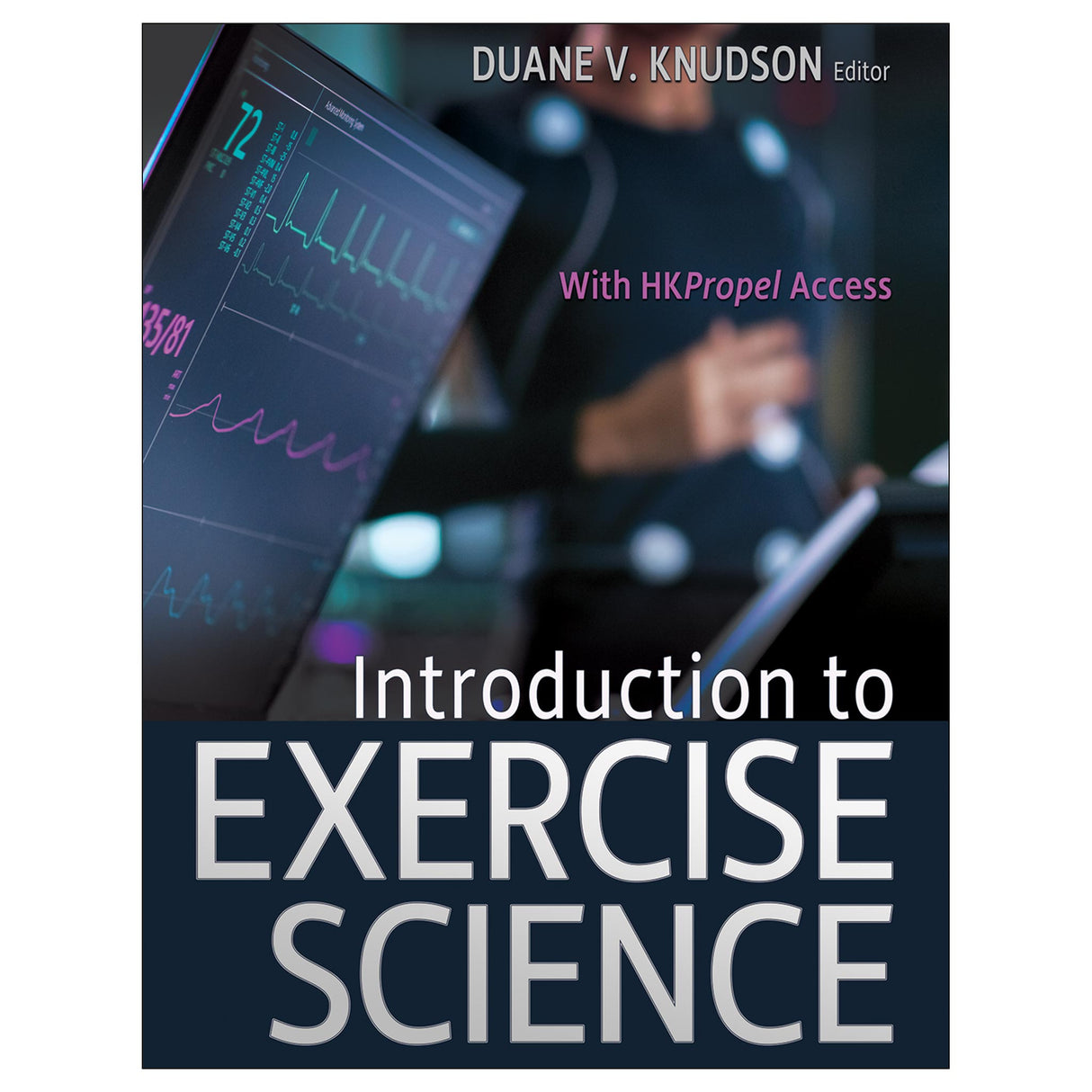Introduction to Exercise Science Ebook With HKPropel Access
Author: Duane V. Knudson
$112.00 USD

Introduction to Exercise Science features a full-color layout and a three-section structure to introduce students to the current issues that exercise science professionals seek to understand to promote better health and performance. Part I examines the scope of the field and summarizes the foundational knowledge needed, like basic musculoskeletal anatomy, measurement, and statistics. Part II delves into five major subdisciplines of exercise science: biomechanics, exercise physiology, motor behavior, sport and exercise psychology, and physical activity epidemiology. Part III elaborates on research methods, evidence-based practice, and professional application in various allied-health-related careers such as athletic training, physical therapy, and occupational therapy as well as sport performance careers such as strength and conditioning, nutrition, and sport analytics.
Introduction to Exercise Science is designed to stimulate student curiosity about the vast field of exercise science and common career paths. Throughout the text, sidebars featuring the latest research and best practices, professional issues and career opportunities, and trending topics in exercise science are used to engage students and reinforce important knowledge in evidence-based practice. Chapter objectives, summaries, key points, key terms, and review questions aid in knowledge retention. Opening scenarios at the beginning of each chapter feature a specific activity, exercise, or health promotion issue that serves to illustrate the importance of that area of knowledge to exercise science.
Related online learning activities include interactive flash cards, key point review questions, research activities, guided notes, and scenario-based exercises to fully immerse students in the various aspects of exercise science. Students will learn how to read and evaluate research and will develop the ability to think critically to confront specific challenges. Most of the activities can be assigned, and progress tracked, directly through HKPropel. Chapter quizzes, which are automatically graded, may also be assigned to test comprehension of critical concepts.
Exercise science professionals require mastery of a complex body of theoretical knowledge about exercise and its application in evidence-based practice. Introduction to Exercise Science will give readers an understanding of how scientific tools and protocols and applied research can contribute to the health and performance of all people.
Note: A code for accessing HKPropel is included with this ebook.
Audience
Introductory undergraduate courses or foundations courses in exercise science or sport and physical activity programs.Chapter 1. The Scope of Exercise Science and Kinesiology
Duane V. Knudson
The Disciplines of Exercise Science and Kinesiology
Sources of Knowledge of Exercise Science
Exercise Science and Professional Careers
Holistic Study of Subdisciplines of Exercise Science
Exercise Science and Evidence-Based Practice
Wrap-Up
Chapter 2. Musculoskeletal Anatomy
Duane V. Knudson
Anatomy and Exercise Science
Structure of the Body
Skeletal Anatomy Preview
Muscular Anatomy Preview
Integration of Anatomy and Exercise Science
Wrap-Up
Chapter 3. Measurement and Statistics
Matthew T. Mahar
Benefits and History of Measurement in Exercise Science
Measurement Concepts in Exercise Science
Statistics Commonly Used in Exercise Science
Wrap-Up
Part II. Major Subdisciplines of Exercise Science
Chapter 4. Biomechanics
Kathy Simpson
Benefits of Biomechanics Knowledge
What Do Biomechanists Do?
History of Biomechanics
Research Methods for Biomechanics
Overview of Knowledge in Biomechanics
Wrap-Up
Chapter 5. Exercise Physiology
Jennifer L. Caputo
Benefits of Exercise Physiology Knowledge
What Do Exercise Physiologists Do?
History of Exercise Physiology
Research Methods in Exercise Physiology
Overview of Knowledge in Exercise Physiology
Wrap-Up
Chapter 6. Motor Behavior
Katherine T. Thomas and Xiangli Gu
Benefits of Motor Behavior Knowledge
What Do Motor Behaviorists Do?
History of Motor Behavior
Research Methods for Motor Behavior
Overview of Knowledge in Motor Behavior
Wrap-Up
Chapter 7. Sport and Exercise Psychology
Lindsay E. Kipp
Benefits of Sport and Exercise Psychology
What Do Sport and Exercise Psychology Professionals Do?
History of Sport and Exercise Psychology
Research Methods for Sport and Exercise Psychology
Overview of Knowledge in Sport and Exercise Psychology
Wrap-Up
Chapter 8. Physical Activity Epidemiology
Duck-chul Lee
Benefits of Physical Activity Epidemiology Knowledge
What Do Physical Activity Epidemiologists Do?
History of Physical Activity Epidemiology
Research Methods in Physical Activity Epidemiology
Overview of Knowledge in Physical Activity Epidemiology
Wrap-Up
Part III. Related Professional Subdisciplines
Chapter 9. Research and Evidence-Based Practice
James L. Farnsworth II and Natalie L. Myers
Benefits of Research and Evidence-Based Practice in Exercise Science
Common Research Designs Used in Exercise Science
Overview of Using Research to Support Evidence-Based Practice
Wrap-Up
Chapter 10. Sport Performance: Strength and Conditioning, Nutrition, and Sport Science
Broderick L. Dickerson, Drew E. Gonzalez, Scott M. Battley, and Richard B. Kreider
What Do Sport Performance Specialists Do?
History of Sport Performance
Research Methods in Sport Performance
Overview of Knowledge in Sport Performance
Wrap-Up
Chapter 11. Medicine and Allied Health
Chad Starkey and Julie Cavallario
Diagnostics in Medicine and Allied Health
Types of Interventive Exercise in Medicine and Allied Health
Roles and Scope of Practice for Medical and Allied Health Professionals
Applied and Translational Exercise Science Research in Medicine and Allied Health
Wrap-Up
Knudson has authored more than 168 peer-reviewed articles, 26 chapters, and three books: Fundamentals of Biomechanics, Qualitative Diagnosis of Human Movement, and Biomechanical Principles of Tennis Technique. He also coedited the top-selling text Introduction to Kinesiology.
He has received numerous state, regional, national, and international awards for his research and leadership, and he has been elected a fellow of four scholarly societies, including the prestigious National Academy of Kinesiology. He has served as department chair, associate dean, and president of the American Kinesiology Association and as president of the International Society of Biomechanics in Sports.
Learn more about physical activity epidemiology
Measurement and statistics in exercise science
What Do Sport Performance Professionals Do?




All ancillaries are free to adopting instructors through HKPropel.
Instructor guide. Includes chapter outlines and suggested lecture structures to aid instructors in lecture preparation. Also includes student activities to facilitate learning and engagement within the classroom. Contains teaching tips, ideas for discussion topics and speakers, and answers to review questions.
Test package. Contains 330 questions in true-false and multiple-choice formats. The files may be downloaded for integration with a learning management system or printed for use as paper-based tests. Instructors may also create their own customized quizzes or tests from the test bank questions to assign to students directly through HKPropel. Multiple-choice and true-false questions are automatically graded, and instructors can review student scores in the platform.
Chapter quizzes. Contains ready-made quizzes (10 questions each) to assess student comprehension of the most important concepts in each chapter. Each quiz may be downloaded or assigned to students directly through HKPropel. The chapter assessments are automatically graded, and instructors can review student scores in the platform.
Presentation package. Features more than 380 PowerPoint slides of text, artwork, and tables from the book that can be used for class discussion and presentation. The slides in the presentation package can be used directly within PowerPoint or printed to make handouts for students. Instructors can easily add, modify, and rearrange the order of the slides.
Image bank. Includes most of the figures, content photos, and tables from the text, sorted by chapter. These can be used in developing a customized presentation based on specific course requirements.
Instructors also receive access to all student materials in HKPropel. For Introduction to Exercise Science, this includes learning aids and interactive activities consisting of flash cards, review questions, research activities, guided notes, and scenario-based exercises. Most of the activities can be assigned and tracked through HKPropel.





